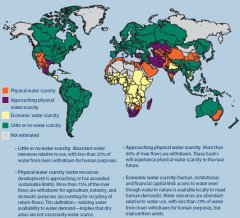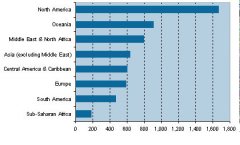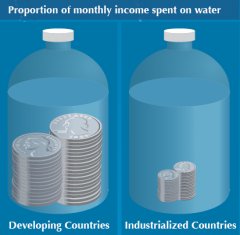Global warming and Water Shortages
 Global warming is expected to account for about 20 percent of the global increase in water scarcity this century. It is predicted that global warming will alter precipitation patterns around the world, melt mountain glaciers, and worsen the extremes of droughts and floods.
Global warming is expected to account for about 20 percent of the global increase in water scarcity this century. It is predicted that global warming will alter precipitation patterns around the world, melt mountain glaciers, and worsen the extremes of droughts and floods.
Global water consumption increased sixfold in the last century - more than twice the rate of population growth - and will continue growing rapidly in coming decades. Yet readily available freshwater is a finite resource, equivalent to less than one percent of the water on Earth.
 What's more, water and populations are unevenly distributed across the globe; arid and semi-arid regions receive only two percent of all surface runoff yet account for 40 percent of the global land area and house half of the world's poor. Finally, our existing freshwater resources are under heavy threat from overexploitation, pollution, and global warming. Given these trends, equitably providing adequate water resources for agriculture, industry and human consumption poses one of the greatest challenges of the 21st century.
What's more, water and populations are unevenly distributed across the globe; arid and semi-arid regions receive only two percent of all surface runoff yet account for 40 percent of the global land area and house half of the world's poor. Finally, our existing freshwater resources are under heavy threat from overexploitation, pollution, and global warming. Given these trends, equitably providing adequate water resources for agriculture, industry and human consumption poses one of the greatest challenges of the 21st century.
The physical evidence of water scarcity can be found in increasing magnitude around the world, affecting rich and poor countries alike. Nearly three billion people live in water scarce conditions (over 40 percent of the world's population), and this situation could worsen if current growth trends continue. The manifestations of pervasive water poverty include millions of deaths every year due to malnourishment and water-related disease, political conflict over scarce water resources, extinction of freshwater species, and degradation of aquatic ecosystems. Roughly half of all wetlands have already been lost and dams have seriously altered the flow of roughly 60 percent of the world's major river basins.
Nearly three billion people live in water scarce conditions (over 40 percent of the world's population), and this situation could worsen if current growth trends continue. The manifestations of pervasive water poverty include millions of deaths every year due to malnourishment and water-related disease, political conflict over scarce water resources, extinction of freshwater species, and degradation of aquatic ecosystems. Roughly half of all wetlands have already been lost and dams have seriously altered the flow of roughly 60 percent of the world's major river basins.
Fig. 1: Areas of Physical and Economic Water Scarcity
 Physical Water Scarcity
Physical Water Scarcity
Water scarcity is not a factor of absolute quantity; it occurs frequently in both dry and moist climates. Rather, it is a relative concept comparing the availability of water to actual use. Desert regions, for example, do not classify as water scarce if demand for water is low. However, scarcity may exist in water-abundant areas if there is heavy population pressure, excessive pollution, or unsustainable consumption levels. Together, these forms of physical water scarcity affect every continent and approximately one-fifth of the world population.


|
Mankind in Decline: Genetic Disasters, Human-Animal Hybrids, Overpopulation, Pollution, Global Warming, Food and Water Shortages, Desertification, ... Genocide, Epidemics, Wars, Leadership Failure Book (Blaha Research) |